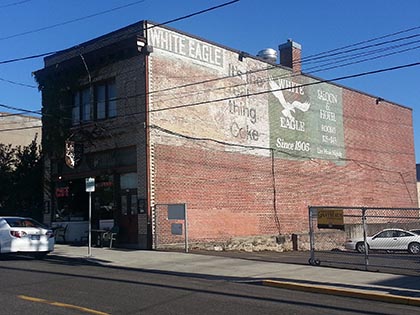Ghost stories haunt century-old east Portland tavern
The White Eagle Saloon has been serving drinks since 1906. It's one of a handful of saloons in which you can enjoy a pint knowing that, 110 years ago, people like you were getting shanghaied out of the place.
EDITOR'S NOTE: A revised, updated and expanded version of this story was published in 2017 and is recommended in preference to this older one. To read it, click here.
By Finn J.D. John — August 23, 2009
Prowling around downtown Portland today, it’s hard to imagine what a rough dockside town it was just after the turn of the century. Two-story docks gave cover to toughs, muggers and shanghai operators beneath, and periodic floods kept everything down there in disrepair — after all, why fix up something that’s just going to be damaged in next year’s flood season?
Add this to a highly volatile mix of ethnic backgrounds — some of them bitter national enemies — and lots of free-flowing booze, and you have a picture of old waterfront Portland, on both sides of the river: a neighborhood that drinks hard, punches harder and goes to an awful lot of funerals for men killed violently when they least expected it.
A place like that is bound to generate a ghost story or two.
Probably the best-known Portland waterfront ghost stories center around the White Eagle Saloon, a smallish pub on Russell Street near the east bank of the Willamette that has been part of the McMenamin brothers’ organization for the past dozen or so years. It’s been there since 1906; since that time, the city around it has changed radically, and its neighborhood has become a sort of triangle-shaped island of 10 blocks or so, bordered on one side by Interstate 405, another by I-5 and the third by the Willamette River.
The pub was founded by a pair of Polish immigrants and for many years it functioned as a sort of headquarters for the east Portland waterfront’s Polish community — in fact, the “White Eagle” refers to the bird you’ll find on the Polish flag of the period.

The White Eagle from another angle, showing the old (and old-looking new)
advertising paintings
on its side. (Photo:
F.J.D. John)
Rumors about the White Eagle are fascinating and mostly (but not all) untrue. Inspired by an old coal chute downstairs that looks like a tunnel entrance and by the mysterious disappearance of the saloon’s muscular Chinese bouncer (one of the saloon’s reputed ghosts), one claim is that shanghai operators ran an opium den in the basement and hauled unconscious victims down to the river through a secret catacomb. This is possible, but unlikely; for Polish longshoremen, opium was hardly the drug of choice, and even as late as 1906 it wasn't necessary to go to the trouble of digging a tunnel for transporting shanghai victims, especially from a rough-cut saloon two blocks from the waterfront. After all, what does a shanghaiing-in-progress look like? Looks an awful lot like a sailor who, having had a little too much to drink, is being helped back to his ship by a couple of his shipmates, doesn't it? Easy money.
The part about shanghaiing is true, though. The golden age of shanghaiing in Portland was the 1890s, but by 1906 things weren't that much better, and as late as 1912 the president of the International Seamen's Union testified before Congress that Portland was the worst nest of shanghaiers in the country. Was anyone ever shanghaied out of the White Eagle? There's no documentary evidence to prove it, but yes, it happened there — you can bet on it. It happened virtually everywhere in waterfront Portland, on both sides of the river.
Another rumor claims that there was a brothel upstairs — which may be true, but more likely stems from the tendency of the dock workers who lived in the upstairs apartments to celebrate payday by purchasing the services of female companions and bringing them home for the night.
Whatever the truth is, there have been quite a few reports of strange happenings at the White Eagle over the years. According to these reports, things get mysteriously thrown around, people feel strange touches, toilets flush for no apparent reason and sometimes people hear things.
According to writer Susan Smitten, a number of psychics have visited the place and report “a sensation of violence and death in the basement, some playful and mischievous energy on the main floor and a deep well of sadness on the second floor.”
Now, you may believe in this sort of thing, or you may think that quote from Smitten is a deep well of something else. Either way, the simple fact that these stories have arisen around a building with such a historic and colorful past makes them worth telling, sharing and remembering for future use around a campfire sometime. And they’re certainly worth bearing in mind if you’re ever in north Portland with an hour or two free to spend ghost-hunting, if you're into that sort of thing -- or just enjoying a quiet pint and thinking about soon-to-be-sailors of the past, if you're not.
(Sources: Smitten, Susan. Ghost Stories of Oregon. Edmonton: Ghost House, 2001; www.pdxhistory.com; www.portlandwaterfront.org; Dillon, Richard. Shanghaiing Days. New York: Coward McCann, 1961)
-30-












